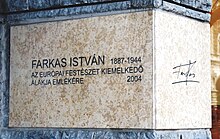István Farkas
István Farkas (born October 20, 1887 in Budapest , † July 1944 in Auschwitz-Birkenau concentration camp ) was a Hungarian painter, publisher and victim of the Holocaust .
Life
István Wolfner's father József Wolfner (1856–1932) was the founder of the magazine and book publisher “Singer es Wolfner Kiadása”. István's mother Anna Goldberger died when he was five years old. Wolfner suffered from his overpowering father, who was also an art collector. Wolfner Magyarized his name to Farkas.
His artistic teacher in Budapest was initially the painter László Mednyánszky . After training with the painters of the Nagybánya artists 'colony , he moved to Paris in 1912 , joined the cubist painters' circle at the Académie de La Palette and became friends with André Salmon , who later wrote a monograph on him. In 1914 he took part in the First World War as an Austro-Hungarian lieutenant and was taken prisoner in Italy.
In 1923 he met Ida Kohner (1895–1944) in Adolf Fényes' studio and after marrying in 1925 had four children with her. Farkas had his first solo exhibition in 1924 with 117 pictures in the Ernst Museum . In November 1925 Farkas moved to Paris, where he became part of the art scene in the Café de la Rotonde on Montparnasse , had solo exhibitions, also in Belgium, and his works were bought. When his father died in 1932, he had to take over the management of the company in Budapest as the sole heir and now also published progressive works with the conservative publisher. He kept his Paris studio, continued to paint there, despite the stress of being general director of Új Idök Kft, and had two major exhibitions in the Ernst Museum in 1932 and 1936.
When the Horthy regime tightened anti-Semitic legislation in 1939 , which had already been introduced in 1919, Farkas, as a Jew, expected the protected status of a decorated war veteran and officer. In 1943 he organized an exhibition in the Tamás Gallery, the catalog contained a foreword by Ernő Kállai . His French co-editor François Gachot, with whom he had published books on József Rippl-Rónai , Tivadar Kosztka Csontváry and Béni Ferenczy , now urgently advised him to leave Hungary.
After the German occupation of Hungary in March 1944, the Eichmann Command, together with the Hungarian authorities, organized the ghettoization and deportation of Hungarian Jews to Auschwitz , starting in the Hungarian provinces. Now Farkas was asked to flee again by the sculptor Pál Pátzay , but Farkas hesitated and resigned. In Budapest he was arrested on April 15, 1944 in a group of 45 Jewish journalists and publicists, including editors from Pester Lloyd , and ghettoized in the camp in Kistarcsa . Farkas was deported to Auschwitz and gassed there. Another letter had been smuggled from the intermediate station in Kecskemét , from which his resignation sounded:
- When human dignity is so humiliated it is no longer worth living.
After the war, his apartment in Aradi utca was confiscated by the Russian occupying forces and his villa in Szigliget was nationalized.
In 1997, Farkas' Portrait of Dezső Szomory became part of the cover design of the first edition of Imre Kertész 's novel Valaki más , and Farkas became known to a wider public again.
Fonts
- A levegő titánjai , Budapest: Centrum, 1942
literature
- Tamás Kieselbach [Ed.]: Modernism in Hungarian Painting , Vol. 2 1919–1964, Berlin: Nicolai, 2008 ISBN 978-3-89479-320-3 .
- therein: Gabriella Kernács: István Farkas (1887–1944): “The painter of the fool of Syracuse” , p. 42f
- therein: Short biography, p. 787
- Katalin S. Nagy : Farkas István . Budapest, 1994.
- Steven A. Mansbach et al. a. [Ed.], Santa Barbara Museum of Art: Standing in the tempest. Painters of the Hungarian Avant-garde 1908-1930 , Cambridge, Mass. [u. a.]: MIT Pr., 1991 ISBN 0-262-13274-5
- André Salmon: Étienne Farkas: essai critique , Edition des Quatre-chemins, Paris 1935
Web links
- Literature by and about István Farkas in the catalog of the German National Library
- Katalin S. Nagy, Imre Kertész : The Farkas Villa , contributions to the exhibition catalog of the Budapest History Museum 2005
- István Farkas Memorial Room, Szigliget Exhibition 2004 in Szigliget
Individual evidence
- ↑ László Mednyánszky in the Hungarian Wikipedia hu: Mednyánszky László (festő)
- ↑ Nagybánya artists' colony in the Hungarian Wikipedia hu: Nagybányai művésztelep
- ↑ Ida Kohner at WorldCat
- ↑ Ernst Museum in the Hungarian Wikipedia hu: Ernst Múzeum . Further information from: Ernst Museum ( Memento of the original dated November 22, 2007 in the Internet Archive ) Information: The archive link was inserted automatically and has not yet been checked. Please check the original and archive link according to the instructions and then remove this notice. Website (s)
- ↑ Ernő Kállai in the Hungarian Wikipedia hu: Ernő Kállai (művészeti író)
- ^ François Gachot at WorldCat
- ↑ Quotation from Gabriella Kernács: István Farkas (1887-1944) , p. 43
- ↑ Kertész Imre: Valaki más. A változás krónikája , Budapest: Magvető 1997. German: I - someone else
| personal data | |
|---|---|
| SURNAME | Farkas, Istvan |
| ALTERNATIVE NAMES | Farkas, Étienne; Wolfner, István |
| BRIEF DESCRIPTION | Hungarian painter and publisher |
| DATE OF BIRTH | October 20, 1887 |
| PLACE OF BIRTH | Budapest |
| DATE OF DEATH | July 1944 |
| Place of death | Auschwitz-Birkenau concentration camp |

